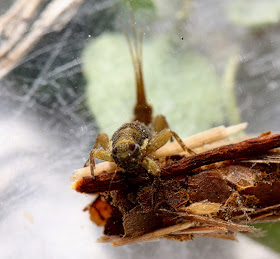Thursday, January 31, 2019
Photos from the Rapidan River
I went up to the Rapidan River on Monday to see if I could find any insects. The water was high and fast, but I found quite a few things in balls of vegetative matter close to shore.
At the top of the page, a pretty cased caddisfly that really drew my attention. The case looked a little unique, and at first I thought it might be a species I'd not seen before.
I preserved it and went home to do some microscope work. The first thing to check was the lateral hump which looked like this.
The orange sclerite behind the hump signaled genus Pycnopsyche. Since I often find Pycnopsyche scabripennis up there in the spring and summer, that immediately came to mind. But the case looked somehow different. At issue, the sticks extending back from the top of the case. This brought to mind P. guttifera, a species that often makes this kind of case. From the descriptions of Pycnopsyche larvae in Beaty's manual ("The Trichoptera of North Carolina," pp. 84-85) it became clear that the choices were guttifera or scabripennis. These species share one thing in common -- both have "2 major setae" on the "ventral margin of the femora" (Beaty, p. 85). That I could see.
(Note that the large setae behind these two is actually on the dorsal side of the femur.) But, the species differ in one significant way -- on the venter of the first abdominal segment, there are more than 15 setae on guttifera, while on scabripennis there are less. Microscope photo.
I've pointed to three of the setae; in all I counted ten. So, I guess it was P. scabripennis after all, just a young one with much room to grow.
Since I was so intent on getting good pics of the caddis, I totally ignored the spiny crawler mayfly that was hitching a ride on its case. Pretty sure it was Ephemerella invaria, but I should have preserved it just to be sure. Very unusual colors.
________________
I got some pretty good photos of two other insects.
1. Small minnow mayfly, Baetis tricauditus, male and fully mature.
and 2. A young "Yellow Sally" stonefly, Isoperla kirchneri group (probably I. montana).
_________________
The Rapidan valley in Winter.
Wednesday, January 30, 2019
Another free-living caddisfly species -- Rhyacophila torva
This is an exciting find I made a few weeks ago while exploring one of my favorite streams in Sugar Hollow. The stream is on the land of a good friend who often goes with me to look for stream insects.
This is Rhyacophila torva, which brings the number of Rhyacophilidae species that we've found so far to seven. It's the distinctive head pattern that convinced me that this was a new one for me, and it's the head pattern that's one of the keys to the species ID.
On R. torva, Beaty says the following: "R. torva -- larva ?? mm; teeth on anal claw present; distinct dark "V" along frontoclypeal sutures with some darker muscle scars behind. Occurs mostly in small Mountain streams. Relatively common. Recorded from GSMNP. (Steven Beaty, "The Trichoptera of North Carolina," p. 61.)
With that, all I had to do was get a microscope shot of the anal claws, and the teeth on the claws was obvious. (In another source -- unpublished -- there's an illustration of an R. torva claw. It too shows a claw with 3 teeth that are progressively smaller as you move the tip to the rear.)
I should add that, yes indeed, it was found in a small mountain stream!
Love finding new things!
_________________________
As you can see from the photo above, it was a gorgeous day, one of the few really nice days we've had so far this winter. Consequently, we found a few other things that made for good photos.
1. Small minnow mayfly, Baetis tricaudatus.
2. A second Rhyacophilidae species -- R. carolina.
and 3. A Roach-like stonefly, Tallaperla sp.
__________________
I'll be posting again tomorrow -- photos from a trip to the Rapidan river I took yesterday. Got some good ones.
One other thing. For the last year I've been actively posting on Instagram. You can find me at: buddhabob2hanlubo.
Big News: Isoperla sp. VA has been identified as Isoperla nelsoni
I have several entries to post, but I'll start with some big news from Steve Beaty. The Isoperla stonefly nymph that we've been finding in a number of small streams in Sugar Hollow which had the temporary designation of Isoperla sp. VA has now been identifed as Isoperla nelsoni. Exciting news to those of us who see it every spring -- usually in April and May -- but have failed to find any adults to help us with the ID.
Isoperla nelsoni, the adult, was first described in a long article by S.W. Szcytko and B.C. Kondratieff, pp. 174-177 in "A Review of the Eastern Nearctic Isoperlinae (Plecoptera: Perlodidae) With The Description of Twenty-two new species," Monographs of Illesia, Number 1:1-289 (2015).
One thing of interest, the head pattern we see on the mature nymph, this,
with a dark patch enclosed in the ocellar triangle and a dark patch anterior to it, shows up as well on the head of the adult. (See the illustration of that on p. 175 of the article.)
Exciting news. We had found this nymph first in May of 2011.

























